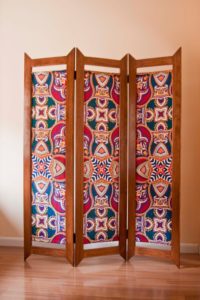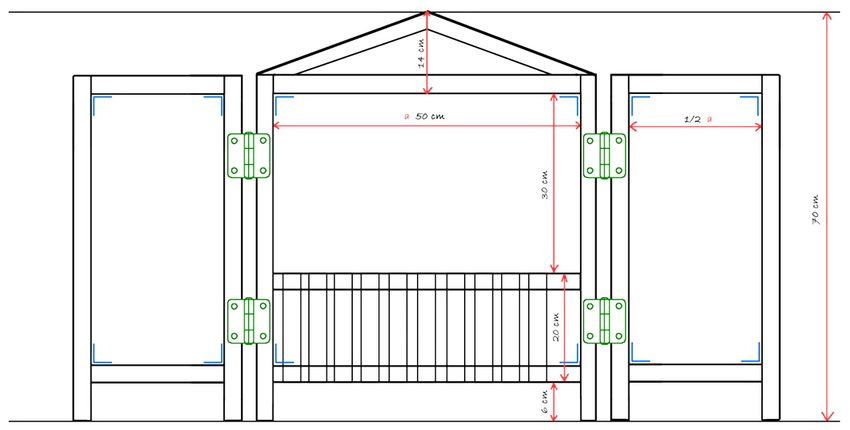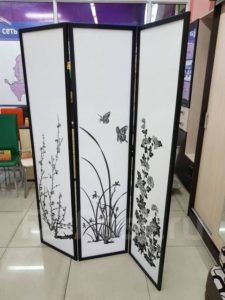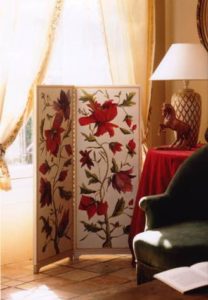DIY screen made of wood
Decorative partitions have been used since ancient times to delimit space. Convenient and practical screens were popular in Rome, Egypt and China many years ago. They were always made from light and simple materials. In addition, they could be structures of various sizes and shapes.
Wealthy people could decorate screens with various types of decoration, such as inlay, painting, carving. With the help of this article you can learn how to make unusual screens yourself.
The content of the article
Selecting materials for creating a screen
 To produce this type of furniture, it is important to determine the materials and design features of the product. Let's take a closer look at what materials and tools it can be made from:
To produce this type of furniture, it is important to determine the materials and design features of the product. Let's take a closer look at what materials and tools it can be made from:
- Tree. Typically, screens were made of wood. For example, from a solid board, slats or beams onto which the material was stretched. The board can be either smooth or with a carved pattern. Interior designers come up with ideas using items that have gone out of use. So, a screen can be constructed from old doors. Of course, you need to first restore the canvas to give it a fresher look. It is better to use it in the house and at the dacha;
- Drill and screwdriver;
- Hacksaw;
- Varnish, paints;
- Wooden bars;
- Construction stapler;
- Furniture hinges;
- Fabric or glass for filling the doors;
- Glazing beads (if the filling of the sashes is glass).
REFERENCE! A cheap material is plywood, which is also a fairly light material and is easy to decorate and process.
Selecting an assembly scheme
 When choosing a future design, it is necessary to take into account convenience, further location, general interior style and other factors.
When choosing a future design, it is necessary to take into account convenience, further location, general interior style and other factors.
The main component of the screen is the frame of the sash. These types of products are the easiest to manufacture. The wooden frame is a regular frame. It can be made in several stages.
How to assemble the product
 Let's look at the step-by-step instructions for assembling a screen with your own hands from wood:
Let's look at the step-by-step instructions for assembling a screen with your own hands from wood:
- Making frames. You will need from two to several dozen of them. It all depends on personal tastes and preferences. The framed screen will have several compartments. It should also be taken into account that such a product may be difficult to transport. In case there are a large number of frames. You also need to take into account the length and height of the future screen.
- We provide the frames with reliable fasteners and install jumpers. It is important to remember that all frame angles are within 90 degrees. Its aesthetics will depend on this.
- Next, we assemble the timber frames. You will need to screw two long bars into the frame (along the height of the product). And also three or four bars that will create the width of the section. It is best to use furniture confirmations for reliability and fastening of the bars.
- The next stage is filling the sections themselves. If glass is used as filling, then it can be installed using the glazing principle. We use a bead for installation. If we use fabric as filling, then we can make a separate frame for the fabric and insert it like glass.In this case, if the fabric tears, it will be easy to replace it with a new one.
- To assemble, you need to combine the sections into a single piece. The connection is made using canopies. They can be selected according to specified parameters in a hardware store. If assembled incorrectly, it will not stand. And thus it can be easily folded and transported. But there are loops that can fold a section in any direction.
ATTENTION! One important thing to consider is that each section should fold in a different direction than the previous section.
Original ideas for creating screens
 You can also use non-traditional materials to create screens:
You can also use non-traditional materials to create screens:
- CDs or vinyl records. You can fasten the disks to each other using threads or staples. This option looks impressive everywhere.
- Branches of bamboo or reed. This is the lightest type of screen in terms of weight. They are also visually simple. Despite their simplicity, they look expensive and can be combined in completely different styles.
- Cardboard screen. The advantage is its low cost and ease of manufacture. You can make a spectacular ornament inside the canvas using a stationery knife. But such a screen is not suitable for the street, as it will quickly become unusable due to weather conditions.
- Plastic panels. This material is also convenient for creating a screen. Now there is a wide variety of plastic panels that can be combined with different furniture. And another advantage is their reliability.
IMPORTANT! Plastic panels can imitate various materials, such as wood or plastic.
We hope this article will help you create a unique design for your home or street. The main thing to remember is that making a screen with your own hands is not so difficult.It is important to choose the right materials for the interior and follow all instructions.





